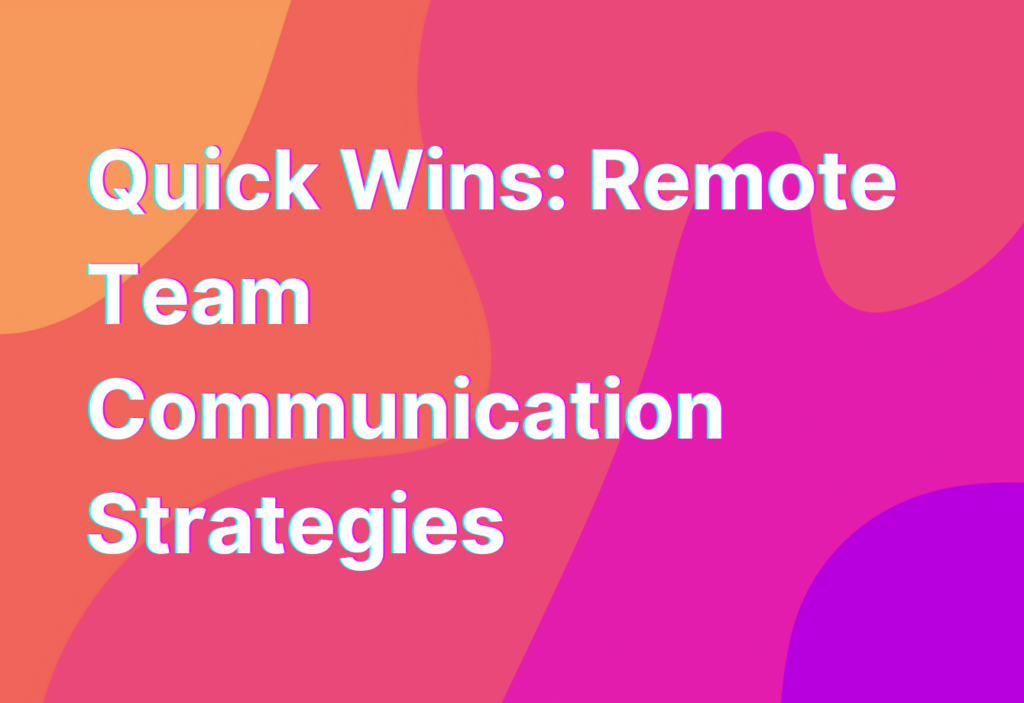Quick Wins: Remote Team Communication Strategies
Hey there, remote work warriors! Ashley here, your friendly neighborhood remote work advocate. Today, I want to talk about quick wins when it comes to remote team communication strategies. As someone with 10 years of remote work experience in the tech industry, I’ve learned a thing or two about keeping the lines of communication open and effective. So, grab your favorite cup of coffee (or tea, if that’s your thing) and let’s dive in!
1. Embrace the Power of Video Calls
When it comes to remote team communication, nothing beats face-to-face interaction. Well, as close as you can get to it, anyway. That’s where video calls come in. Platforms like Zoom, Microsoft Teams, and Google Meet have made it easier than ever to connect with your team members visually.
Not only do video calls allow you to see each other’s facial expressions and body language, but they also help foster a sense of camaraderie and connection. Plus, let’s be honest, it’s always fun to see what kind of quirky backgrounds your colleagues have chosen for the day!
So, the next time you have a team meeting or need to discuss a project, opt for a video call instead of a regular old audio call. Trust me, it makes a world of difference.
2. Utilize Project Management Tools
Remote work often requires juggling multiple projects and tasks simultaneously. That’s where project management tools like Trello, Asana, and Monday.com come in handy. These tools allow you to create tasks, assign them to team members, set deadlines, and track progress all in one place.
By utilizing project management tools, you can ensure that everyone on your team is on the same page and knows exactly what they need to do. Plus, it eliminates the need for constant back-and-forth emails or messages asking for project updates. Talk about a time-saver!
So, if you haven’t already, give project management tools a try. Your team will thank you, and you’ll wonder how you ever survived without them.
3. Establish Clear Communication Channels
When you’re working remotely, it’s crucial to establish clear communication channels to avoid any miscommunication or confusion. Whether it’s through email, instant messaging platforms like Slack, or dedicated communication tools like Twist, make sure everyone on your team knows where and how to reach each other.
Additionally, consider setting guidelines for response times. This helps manage expectations and ensures that urgent messages are addressed promptly. After all, nothing is worse than waiting hours for a response when you need an answer ASAP.
By establishing clear communication channels and response time expectations, you’ll create a more efficient and productive remote work environment.
4. Foster a Culture of Openness and Transparency
Remote work can sometimes lead to feelings of isolation or disconnection. That’s why it’s essential to foster a culture of openness and transparency within your remote team.
Encourage team members to share their thoughts, ideas, and concerns openly. Create a safe space where everyone feels comfortable speaking up and offering feedback. This not only strengthens the bond between team members but also leads to better collaboration and innovation.
Remember, remote work doesn’t have to mean working in silos. By fostering a culture of openness and transparency, you’ll create a remote team that thrives on communication and collaboration.
5. Schedule Regular Check-Ins
When you’re not physically in the same office, it’s easy for team members to feel disconnected or out of the loop. That’s why scheduling regular check-ins is crucial for remote team communication.
Whether it’s a weekly team meeting, a one-on-one catch-up, or a quick virtual coffee break, make sure to set aside time for regular check-ins with your team members. This allows everyone to stay updated on projects, address any concerns, and simply catch up on each other’s lives.
Regular check-ins not only help maintain strong communication within your remote team but also foster a sense of camaraderie and support. Plus, who doesn’t love a good virtual coffee break?
Wrapping Up
And there you have it, my fellow remote work enthusiasts! Quick wins when it comes to remote team communication strategies. By embracing the power of video calls, utilizing project management tools, establishing clear communication channels, fostering a culture of openness and transparency, and scheduling regular check-ins, you’ll set your remote team up for success.
Remember, effective communication is the key to a thriving remote team. So, put these strategies into action and watch your team’s productivity and collaboration soar!
If you want to dive deeper into remote team culture and effective communication strategies, be sure to check out Remote Team Culture: Effective Communication Strategies on our website. It’s a treasure trove of valuable insights and tips.
Until next time, keep rocking that remote work life!


